Indiana farmer Jason Mauck shares his system of relay cropping, which maximizes what plants need: sunlight, water and CO2
Acres U.S.A. Can you explain your context — where you’re farming and what your operation basically looks like?
Jason Mauck. Yeah, that context is important to understand. Both sides of my family farmed, and both sides were very successful and owned big blocks of land. They never spent a dime unless it was on land, and they never took on debt — which has worked out very well, because we own 1,800 acres now, and we farm a total of about 2,600. And then we built hog barns in the last 20 years. We’ve built four barns, so we have about 12,000 pig spaces and about four million gallons of hog manure a year, which we distribute on our land base around the barns. So, it’s a unique context — we get about 45 inches of rain, and I have unlimited fertility, and that creates its own problems, with phosphorus tie ups and things like that.
I went to a small school growing up, and I had my eyes set on making decent money out of college, so I went to Indianapolis and sold insurance for a couple years and learned the business side of things. But I just hated being cleaned up, so I started a landscaping business and grew that till I was 28.
And then my dad got pancreatic cancer. I watched him go from very healthy to passing about four months later. But he had shown me how to do everything that he did. So I was transplanted out of this freedom of running a landscaping business into farming. I had a good relationship with him; it was just such a life change for me. I poured everything into work. I shut off my past life to really immerse myself into understanding farming, because I didn’t want to fail, with that responsibility. So I really got into the industrial ag mindset.
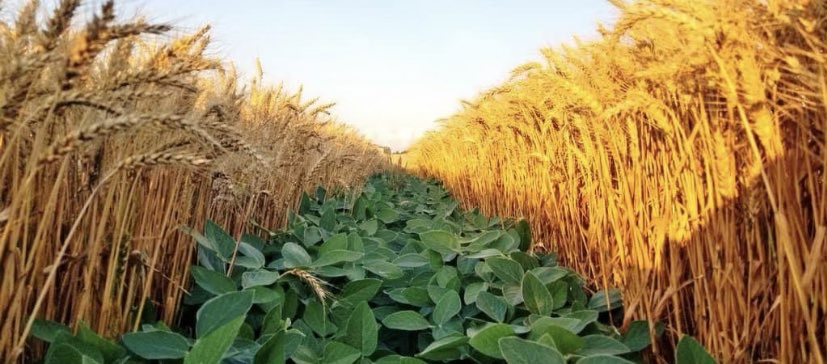
Acres U.S.A. When you were younger, had you envisioned coming back to the farm?
Mauck. I eventually thought that would happen, yeah.
Acres U.S.A. Was the farm able to support another salary at the time? Was that the reason you didn’t stay?
Mauck. Yeah, the salary part hasn’t changed! But that’s created the path to do other stuff. I mean, there’s plenty there, and that’s always been my mindset — that the land is this amazing asset. If I would just change, then I can reflect what I do on that land. So yeah — that’s always been a focus.
But after my dad died, my uncle Lewis kind of became my second dad. But then he got a big brain tumor and passed very quickly at 53, just a few years later. That created this void. It’s not hatred — but I don’t really like industrial ag, and I’m trying to figure out how I can change things — to change the soil and then change the lifestyle.
Before I came back to the farm, I took my landscaping business in a completely different path. I was a marketing major, but I always thought advertising was a waste of money. So I would do these things called living billboards where I would grow flower arrangements in front of properties. And I would manage people’s landscapes and turf like I was farming. I understood that I could plant a summer annual in mid-April — pretty early — and I wouldn’t have to plant many plants. So I started intercropping my annual summer flowers into my spring bulbs. This would allow them to root down and get established so I didn’t have to water them all summer. I just found the plants that were really resilient and kept my bouquets within 12 to 15 different flower species.
Acres U.S.A. So it’s really your landscape background that’s informing your thought about timing and space for row crops.
Mauck. Yes. Everyone else would listen to the salesmen and the retailers and go spend all this money to get a big flower right then. But I’d just harvest my canna bulbs and was able to charge people $500 three times a year and have less than $100 in plants. That was a super moneymaker for me — not only as individual entity, like how Joel Salatin talks about looking at each entity as a profit center — and it had a lot of intrinsic ancillary benefits.
So, I got into farming, and we’re pumping this manure everywhere, and we’ve got super thick chickweed and hemp, and we have this really high-nitrogen, stagnant soil. When the Enlist soybeans were coming out, and I had sprayed hundreds of acres with manure, I thought, “Man, I could just plant wheat and beans in the same field.” So that’s how I started polycropping. And then, with observation, it became this kind of calculus of epigenetics, expression and inflection, where I would change my densities and spacing and I would see these huge differences in how the crops would react to one another, based on how I would arrange the plants.
Acres U.S.A. Can you go into some specifics on that? Do you even call it a rotation? It’s really relay cropping.
Mauck. Yeah, it’s relay cropping. I try to set it up with early corn, so we can get the wheat out there and get it tillering, because that’s important in this wider schematic. I started with twin thirties — two rows of wheat that you drill seven and a half inches apart, with a 22-inch gap in between.
The problem is that with all my fertility, the wheat tillers out and closes that gap. When people have less-fertile soil, the wheat grows more vertically, but my wheat tillers. Some of that might be my climate as well — I’m a little bit farther south, and that gives me more of a growing season to let the compound interest play out.
That was where we started. We’re at quad sixties now. In 2015 and ’16 we did twin thirties, but the beans sucked — they just didn’t get any light. So then the next year I went to 37.5.
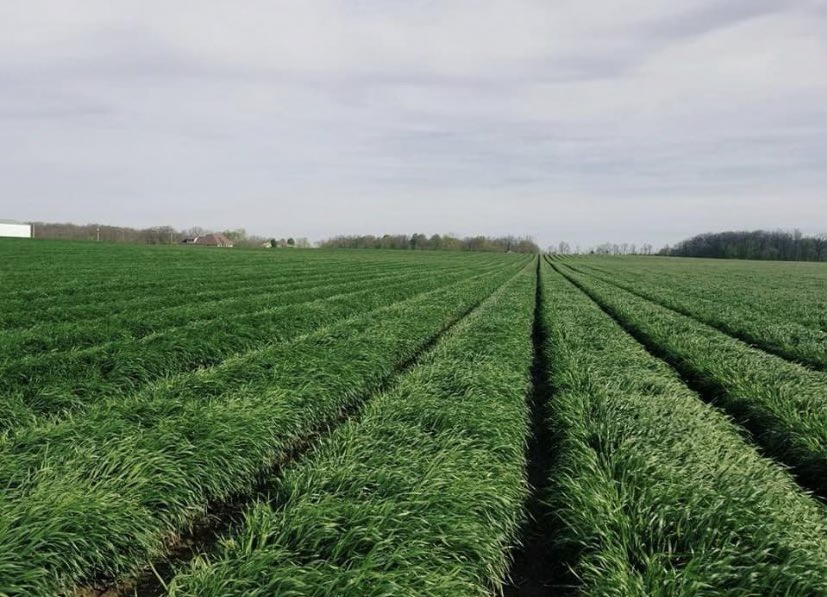
Acres U.S.A. And you’re planting beans in the spring before the wheat comes off, right — you’re planting the beans right down the middle between the twin rows of wheat?
Mauck. Yep. So we went with 30 inches between rows, and then 37.5 — and I actually crossplanted that year, and we combined it without pads — we just cut the wheat heads off. And we had pretty good results that year. We planted the beans in March, and we had really good beans and really good wheat.
You know, precision farming is great, but it doesn’t allow you to learn very quickly. Whenever I do something, I do something small and cheap, in many different ways. And I really learn from the iterations of guess rows, or traffic. You learn a lot quicker if it’s imperfect because you see all these iterations throughout the field. And then it’s also a good idea to change your seeding population and different management strategies. You end up with stacked experiments, with different spacings and populations of fertility.
So, that year it rained a bunch, and we had decent crops. But I was doing this math in my head, realizing that wheat is only worth half as much as beans. If I could create an algorithm where I could milk the curve on the wheat and plant less seed, cut my inputs to nothing, and then have similar or maybe even better soybeans — that would year in, year out be more profitable, right?
So, in 2018, we actually seeded our wheat with a manure tanker. I made a Gandy box, and we devised a thing to divert the seed into the seed discs, and I just drove really fast. The wheat wasn’t great, but it tillered really hard, and then we had 108-bushel soybeans that year. We had phenomenal beans.
But I knew I could do better on the wheat. So, we went back to the drill, and now we’re primarily quad-row sixties for wheat — 60 inches on center, with a wheat strip 22.5 inches wide. That leaves a 37.5-inch gap in between. It’s a relatively big gap. You get a fallow effect. In the middle of that row, the wheat isn’t going to take all the moisture. So I figured out that if I get off of that wheat row about 11 inches, I can plant twin-row beans — 18-inch twins.
I try to plant at first, and then I spray a residual with a little 2,4-D, and then I’m pretty much good. I can go back and spot spray a little bit, but it pretty much takes care of that, because the wheat will grow. Both edges will actively grow laterally sideways, and it will nearly fill in that gap. It leaves us little solar corridor right in between.
And then what happens is that the wheat is a hog, vegetatively, from April to about May 20. And then when it starts putting the heads on, it gets upright, so it then creates a much bigger solar corridor.
Acres U.S.A. That’s interesting. It’s actually changing its shape.
Mauck. Exactly. What happens is that you’re planting 22 inches of the 60 with wheat, and it laterally grows out to about 45 or 50 inches wide. You can easily take a handful of wheat on one side and a handful on the other and they’ll touch. You create a 50-inch-wide shape, and it creates the shape of phi — 1.618. That’s where the golden ratio comes in. In the center of the row, the wheat has to grow vertically, like a tree in the forest; it’s competing, growing as tall as possible. On the south end of the row, it’s going to strive out, just like a tree on its own would. It’ll strive out more towards the south, and the north side will be steeper. I know this is dorky math language, but this is very important when you start thinking in a completely different paradigm with polycropping. You have to look at it through the lens of a plant.
If I plant a regular monocrop of corn, or wheat, with linear sun capture, and then I cut what I plant in half, I’m not going to get half yield, because there’s still the same amount of water and CO2; I’m gonna get about 85 to 90 percent of yield at half. If I shaved that back to a quarter, I’m not gonna get a quarter of the monocrop’s yield; I’m gonna get 60 to 65 percent. That’s where the leverage comes in. I still get a good yield by only planting a quarter or a half of the seed.
Acres U.S.A. This is really interesting. We did an interview with Dr. Erica Steiger from Cornell, who specializes in the system of root intensification — SRI — where you plant smaller seeding rates, and your goal is to increase tillering.
Mauck. Yeah, and it’s just a time progression. If you double a penny every day, you don’t have much for the first 10 days, but pretty quick you become Warren Buffett. If you can plant a full-season soybean, you change its context when you prune the biomass of the wheat. You get a full-season bean to bloom before the summer solstice, and then you allow it to have three to five times as much light, especially for about a three- to five-week time period during the pruning of the biomass. And then you’re engaging every single node of the soybean plant — whereas in a monocrop situation, you’re only capturing light at the top of the plant, with this system I’m describing, you’re capturing light on every single leaf. You empower every part of the plant.
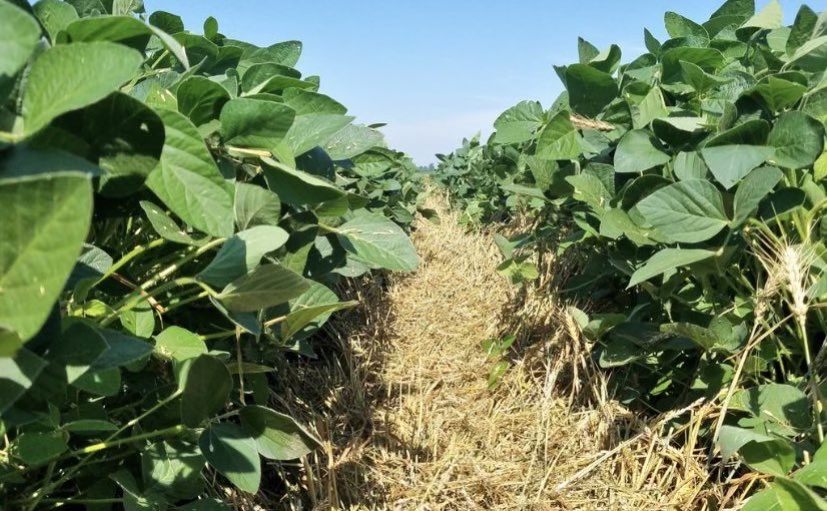
Acres U.S.A. That’s great. What is your seeding rate, then?
Mauck. It depends on the fertility. If we’re around our hog barns, and we’re following fall-applied manure, we’re gonna cut that back to about a third of normal seeding population, so around 500,000 seeds. We’ll actually cut back the row population on the drill. And if we’re in lighter soil, without a bunch of fertility, we’ll increase it to around a million.
We’re figuring out the actual physics of this relay cropping system — understanding the constraints — and then we’ll eventually figure out how to hack that down and take out technology. It’s like stockcropping [grazing animals on strips of cover crops between strips of corn] — it literally is this algorithm that exponentially increases the amount of food that can be grown on an acre. You’re systematically producing the edge effect. People have done studies growing corn and soybeans in the same field, and as the strips of corn get smaller and smaller, the ROI goes up.
People get excited about automation with combines and whatever, but it’s so much more important to think about planting geometry than to have perfect placing on your seeds in a monocrop situation. Especially with wheat and soybeans — I can have all the technology in the world when I plant, but what’s happening when I leave the field? If I have a cereal that’s going to infiltrate water and create a better venue for the oxygen and the microbes in the soil health attributes for the soybeans, then I’m basically empowering technology through arrangements of different plants.
Acres U.S.A. Can you explain a bit more what you mean by the edge effect?
Mauck. Yeah, it’s very similar to how we spread our wheat rows out. If I plant four rows of corn, then I can plant the outside rows thicker. I can very easily achieve twice as much row yield of corn by empowering all the leaves on it. I did a study in 2017. My kids were being potty trained, and I just had them pee on the corn plant every day, and they got 31 ears. Everything is fractal in design. What you do with stock cropping is you plant narrow strips of corn. And then in between the corn, you plant a cover crop. And then you create this ratcheting algorithm where you move the livestock over that cover crop every three or four weeks, so they’re constantly ruminating on it. You feed the corn to the animals, you increase the fertility in the soil, and then you plant your corn where the animals were the previous year.
Acres U.S.A. So with your relay cropping, the principle is that you’re maximizing your edges.
Mauck. Exactly. I’m doing it with two different crops. I exploit plant epigenetic potential on two different crops in two different seasons. From mid-April to late-May, all the tillers on my wheat are getting converted into wheat heads, because they have what wheat wants — they have sunlight, water and CO2. So I get five heads of wheat, instead of one and a half, per seed. Then my beans — I plant really early, full-season, and they get more light, and then my plant yield goes up on that. I aggregately spend a lot less money on inputs, and my total yields go up.
Acres U.S.A. Yeah. It’s the same principle as the system of root intensification.
Mauck. Yes — but twice. There’s really no value in doing it with one crop. There is somewhat — you’ll milk the curve back, and you can get nearly the same yield. But when you can grow a crop that is a cereal that will grow when it’s 37 and raining, and as soon as the sun comes out is gonna grow and tiller — you start getting value the entire year.
Acres U.S.A. What do you do in terms of nutrition management? Any foliar feeding?
Mauck. We’ve done some stuff on the soybean side. But on the wheat side, anything that increases wheat yield is going to rob from my soybeans, as far as moisture and time progression. If I go out and put a bunch of sulfur or fungicide on my wheat, and I delay harvest five days, then I may have added five or 10 bushels of wheat yield, but if I hurt my bean yields that much — those are worth twice as much. We try to have that Mark Shepherd mindset — sheer, total, utter neglect. Low population, we get what we get; we use it as pattern tile and zone weed control.
Acres U.S.A. The wheat is functioning as a cover crop, essentially.
Mauck. Exactly.
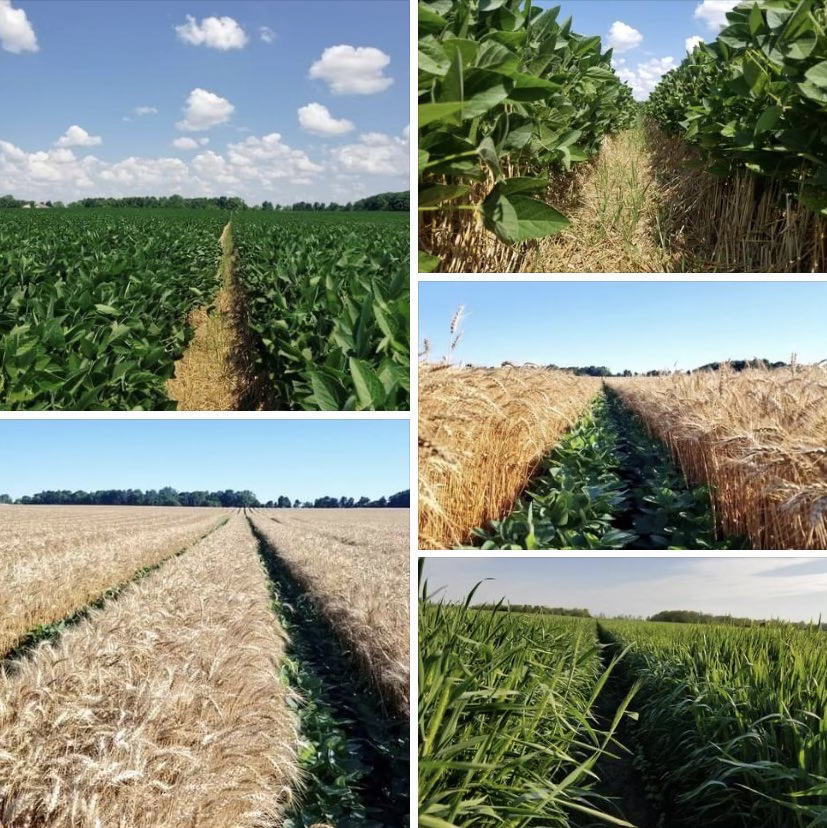
Acres U.S.A. So then, going forward, you harvest your beans — and then what?
Mauck. We harvest our wheat around the fourth of July. And then we usually have quite a bit of volunteer wheat, especially if we get some good summer moisture. We harvest the beans, and we usually go back to corn, usually after applying more manure on that ground.
Acres U.S.A. Do you do any kind of cover crop over the winter, after the beans?
Mauck. We have an insane amount of volunteer wheat. You go back to that rice system — it’s root intensified. It has these big clumps out there. We still do tillage on our farm for the most part; we do some no-till, but we have seen our soil attributes change in that system. We usually are applying manure and then just using tillage to kill the weeds.
Acres U.S.A. And then you go back to corn.
Mauck. Yes. Now Grandpa — he’s in the nursing home, and he’s a very strong character. But once he slows down, I know exactly what I want to do. And that would be to go to twin 60-inch corn and actually seed my wheat earlier, in between the rows, and go after that heavy tillering idea.
Acres U.S.A. So you’re still held back a little bit because your Grandpa doesn’t want you to do this technique.
Mauck. He thinks what I’m doing is hogwash. He hates GPS. I’m always telling him he’s got to change his fields, but it’s so intimidating for him. I mean, I still put the crop out — he just gives me crap for everything. Like, last year, I planted 250 acres green, and it ended up being fine, but there were voles that would eat little spots. And it just doesn’t look perfect.
Acres U.S.A. But what’s your profit? It doesn’t really matter how it looks if it makes you more money, right?
Mauck. Well, it doesn’t really matter if you have 85 percent crop insurance with a rider on it. I could go on a lot of tangents here. But we’re the only hog farmers in the county. Some people are like, “Well, you have all that fertility, so you can do that.” And there’s some truth to that; it does become a lot more profitable of an enterprise. We haven’t put P or K on our ground for 12 years now — ever since I came to the farm. We used to put a full rate of anhydrous, a full rate of P and K, and manure on it.
Acres U.S.A. Can you talk about the hog operation? That’s been going for a long time?
Mauck. They are Tyson pigs. And that’s just continued to grow. And now some farmers have tried to build new barns, and it’s been a community uproar. I’m a director on a feed about three miles north of my house, and we feed about 200,000 pigs out of that feed mill. So, we’re in this heavy livestock area.
Acres U.S.A. So, Tyson is handling all the logistics, right?
Mauck. Yep, it’s their feed, and they do all the loadouts — all that stuff. But I do everything about 20 different ways. You know, I get it — I see the problems, and I don’t defend the industry. It’s just the way it is; 99 percent of pigs are grown like that. But my cousins have a show-pig business, so I get all their seconds and I put them out on the woods to show the difference. We could go on all kinds of tangents about using livestock for intergrazing.
Acres U.S.A. Yeah, that’s a really difficult one in terms of the principles of soil health. How do you market those pigs you have in your woods?
Mauck. We’ll have them harvested, and then we call them “magic pork chops,” and we just put content on Facebook and Twitter. I have a lot of people that have businesses who’ll buy different parts of those pigs and put their own special bacon cure on it or whatever. It’s a coveted, finite product.
Acres U.S.A. And what’s the difference between the products — coming out of your woods versus coming out of the houses?
Mauck. It’s tremendous. It’s much darker in color, and it’s got marbling throughout it. And it’s a completely different texture.
Acres U.S.A. And you’re feeding them the same feed, approximately?
Mauck. Well, my neighbor has non-GMO corn, and he has a bin with his seconds. So they get that and also the fines from our grain. It takes a little longer to grow.
Acres U.S.A. And you have a decent processing facility for that? That can be a real challenge.
Mauck. That’s been the biggest asset of Muncie meats — a company we bought a few years ago. We’ve invested heavily in processing equipment, and at one point we had 40 employees that could cut meat. We have animals harvested in different kinds of facilities that are closer to farmers, and then we can bring that product in. I have a lot of things going on at different stages! We’re constantly just trying to figure things out, finding our opportunities.
Acres U.S.A. Do you ever bring cattle onto your fields to graze?
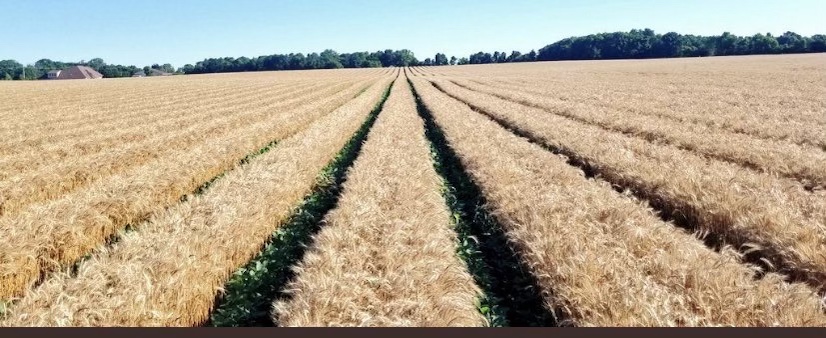
Mauck. My uncle has some cattle. I would love to graze cattle after fall corn harvest. That would be a big part of a future system. My ideal cropping system would be using the exterior of the field — like the outside 80 feet — to be rotationally grazed with mama cows and calves. And then you would grow wide-row corn, and interseed a cereal with a broadleaf, and harvest that off. And then let the cattle systematically cell-graze that over the course of the fall, until the winter. And then the wheat strips will come up and be grazed three or four different times, and then you go into the relay. That would be perfect.
Acres U.S.A. How many months of the year does that leave, then, when you can’t have them on the field — and what you do with them at that point? I think this is the real sticking point with integrating livestock.
Mauck. Yeah, that’s the thing — you have to have a multi-faceted approach. My uncle David already has about 10 places he puts his cattle. In Indiana you have a wet woods on every farm. You have all these pastures, and all these people on 10 acres — they have maybe eight acres of grass, and he goes around and bales that and puts cattle on it.
Acres U.S.A. But that’s so challenging. You have to find those little places, and you have to have the transportation for your cattle. You have to put up corrals, so that you can get them in and out.
Mauck. Oh, yeah, it’s a big deal. You have to have perimeter fencing around all these places.
Acres U.S.A. Have you had any thoughts about doing non-GMO grains? You said your neighbor is doing that. I know that there’s lots of problems with facilities for that and contamination from GMO grains.
Mauck. He has to truck it all the way down to downtown Indianapolis. It’s like an hour and a half drive each way. But he’s got eight employees, so they just do that all offseason. They’ll be out there at five in the morning, and they try to get two or three trips in a day.
My interest is how we can decentralize that to make direct conduits to value. But that’s not realistic if you live in a market where the salaries are going down. And that’s the whole problem. You’re increasing the cost of food. There are people in affluent neighborhoods that demand that, so somebody is going to meet that demand, and it might as well be you. And you’re a weirdo, and you don’t have the camaraderie of doing what everyone else does. But that is a choice.
Acres U.S.A. How do you find labor in your area?
Mauck. Well, it’s been such a blessing. Everything that I do attracts a lot of younger people that think this through, and they want to be a part of it. I get a lot of people that are really interested in it.
Come learn more from Jason Mauck at the AcresUSA Eco-Ag Conference, 4-8 December in Covington, Kentucky. events.acresusa.com
















